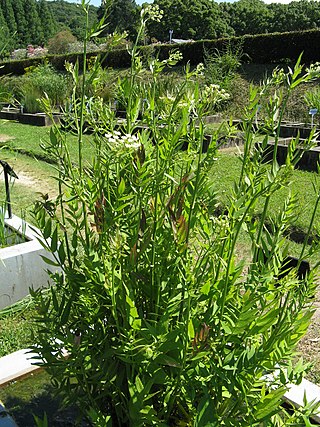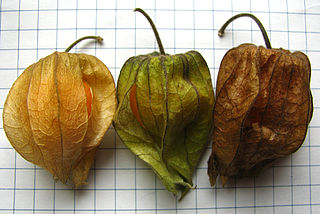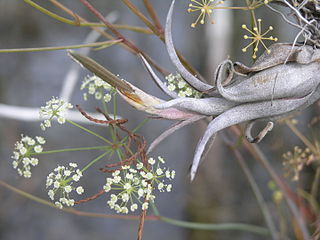
Allium tricoccum is a bulbous perennial flowering plant in the amaryllis family Amaryllidaceae. It is a North American species of wild onion or garlic widespread across eastern Canada and the eastern United States. Many of the common English names for this plant are also used for other Allium species, particularly the similar Allium ursinum, which is native to Europe and Asia. An edible plant, Allium tricoccum is used in a variety of North American and indigenous cuisines, and has also been used by Native Americans in traditional medicine. A French rendering (chicagou) of a Native American name for this plant is the namesake of the American city of Chicago.

Cicuta virosa, the cowbane or northern water hemlock, is a poisonous species of Cicuta, native to northern and central Europe, northern Asia and northwestern North America.

Claytonia virginica, the Virginia springbeauty, eastern spring beauty, grass-flowernarrowleaf springbeauty or fairy spud, is an herbaceous perennial plant in the family Montiaceae. Its native range is eastern North America. Its scientific name honors Colonial Virginian botanist John Clayton (1694–1773).

Allium canadense, the Canada onion, Canadian garlic, wild garlic, meadow garlic and wild onion is a perennial plant native to eastern North America from Texas to Florida to New Brunswick to Montana. The species is also cultivated in other regions as an ornamental and as a garden culinary herb. The plant is also reportedly naturalized in Cuba.

Cicuta, commonly known as water hemlock, is a genus of four species of highly poisonous plants in the family Apiaceae. They are perennial herbaceous plants which grow up to 2.5 meters (8 ft) tall, having distinctive small green or white flowers arranged in an umbrella shape (umbel). Plants in this genus may also be referred to as cowbane or poison parsnip. Cicuta is native to temperate regions of the Northern Hemisphere, mainly North America and Europe, typically growing in wet meadows, along streambanks and other wet and marshy areas. These plants bear a close resemblance to other members in the family Apiaceae and may be confused with a number of edible or poisonous plants. The common name hemlock may also be confused with poison hemlock, or with the Hemlock tree.

Sagittaria latifolia is a plant found in shallow wetlands and is sometimes known as broadleaf arrowhead, duck-potato, Indian potato, or wapato. This plant produces edible tubers that have traditionally been extensively used by Native Americans.

Cicuta maculata is a highly poisonous species of flowering plant in the carrot family known by several common names, including spotted water hemlock, spotted parsley, spotted cowbane, and the suicide root by the Iroquois. It is native to nearly all of North America, from northern Canada to southern Mexico.

Ligusticum porteri, also known as oshá, wild parsnip, Porter’s Lovage or wild celery, is a perennial herb found in parts of the Rocky Mountains and northern New Mexico, especially in the southwestern United States.

Viola sororia, known commonly as the common blue violet, is a short-stemmed herbaceous perennial plant native to eastern North America. It is known by a number of common names, including common meadow violet, purple violet, woolly blue violet, hooded violet, and wood violet.

Apocynum androsaemifolium, the fly-trap dogbane or spreading dogbane, is a flowering plant in the Gentianales order. It is common across Canada and much of the United States excepting the deep southeast.

Oxalis violacea, the violet wood-sorrel, is a perennial plant and herb in the family Oxalidaceae. It is native to the eastern and central United States.

Sium suave, the water parsnip or hemlock waterparsnip, is a perennial wildflower in the family Apiaceae. It is native to many areas of both Asia and North America. The common name water parsnip is due to its similarity to parsnip and its wetland habitat. The alternate common name hemlock waterparsnip is due to its similarity to the highly poisonous spotted water hemlock.

Physalis heterophylla, colloquial name clammy groundcherry, is species of herbaceous plant in the family Solanaceae. It is native to North America, occurring primarily in the eastern United States and Canada. It is known to occur in all contiguous states except for Nevada and California. It is found mainly in habitats such as dry or mesic prairies, gravel hills and rises, sandy or rocky soils, and waste places such as roadsides.

Cicuta bulbifera, commonly known as the bulb-bearing water-hemlock, is a plant native to North America and one of four species in the poisonous genus Cicuta. Tiny bulbils form in the leaf joints in the upper part of the plant, giving the plant its scientific and common names. Cicuta bulbifera can be distinguished from Cicuta douglasii by its narrow leaflet segments and its bulbil-bearing upper leaf axils.
A cataract bog is a rare ecological community formed where a permanent stream flows over a granite outcropping. The sheeting of water keeps the edges of the rock wet without eroding the soil; in this precarious location no tree or large shrub can maintain a roothold. The result is a narrow, permanently wet, sunny habitat.
Dropwort is a common name for several plants and may refer to:

Oenanthe crocata, hemlock water-dropwort is a flowering plant in the carrot family, native to Europe, North Africa and western Asia. It grows in damp grassland and wet woodland, often along river and stream banks. All parts of the plant are extremely toxic and it has been known to cause human and livestock poisoning.

Tiedemannia filiformis is a species of flowering plant in the carrot family known by the common names water cowbane and water dropwort. It grows in swamps, freshwater wetlands, and along the borders of ponds in the southeastern United States, as far north as Delaware, as well as the northern Bahamian pineyards of the Bahamas.

Aureolaria pedicularia, the fernleaf yellow false foxglove, fern-leaved false foxglove, or fernleaf false foxglove, is a parasitic plant of the family Orobanchaceae. Aureolaria pedicularia is native to parts of the eastern US, the Midwest, and adjacent Canada. This plant is known for its distinct leaf shape and overall plant size. The common names for Aureolaria pedicularia come from its fern-like leaves.

Oxypolis is a small genus of North American flowering plants in the carrot family known as cowbane, water dropwort, dropwort, hog-fennel, and pig-potato. As of 2020, Kew's Plants of the World Online accepts four species in the genus Oxypolis:



















